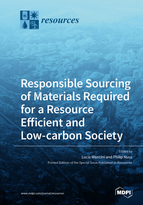Responsible Sourcing of Materials Required for a Resource Efficient and Low-carbon Society
A special issue of Resources (ISSN 2079-9276).
Deadline for manuscript submissions: closed (15 December 2018) | Viewed by 98275
Special Issue Editors
Interests: Raw Materials; Sustainability; Life Cycle Assessment; Responsible Sourcing; Social and Environmental Impact Assessment
Special Issue Information
Dear colleagues,
Our modern economy relies on the quality and availability of natural resources. Driven by population growth and economic development, future demand for natural resources is expected to further increase in coming decades. Natural resources such as metals, non-metallic minerals, and biomass will be an important part of society’s future material mix as countries increasingly transition towards resource efficient and greenhouse gas neutral economies. These materials are also fundamental to meet ecological and socio-economic targets within the Sustainable Development Agenda of the United Nations. For instance, they have a fundamental role in renewable energy technologies, new building materials and infrastructure, modern communication systems, and low-carbon transportation.
However, some materials are largely supplied from countries with poor governance and the future availability of these materials could be threatened by various factors. The resource criticality studies developed in recent years have explored economic, geo-political, and technological factors that could affect the raw materials’ security of supply. Environmental and social pressures can also play a role in the materials security of supply and present obstacles to a future transition to a low-carbon society. For instance, conflicts can prevent access to mineral deposits; accidents and environmental damages compromise public acceptance and can hinder future extraction operations.
From the industry perspective, companies increasingly evaluate and report environmental and social performance. Responsible sourcing of minerals and supply chain due diligence are sometimes integrated in companies’ risk management strategies.
In this special issue we would like to gather papers aiming at:
- Monitoring and assessing social and environmental pressures in material supply chains (e.g., with social and environmental life-cycle assessment)
- Exploring the role of social and environmental pressures in resource security of supply assessments
- Discussing how social and environmental consideration could be increasingly considered in future-looking scenarios of materials needed in the increasing transition to resource efficient and greenhouse gas neutral societies (e.g., metals used in renewable energy systems)
- Reflecting on certification and other approaches for responsible sourcing of resources
- Discussing supply chain due diligence approaches and their implementation from a company perspective
Dr. Lucia Mancini
Dr. Philip Nuss
Guest Editors
Manuscript Submission Information
Manuscripts should be submitted online at www.mdpi.com by registering and logging in to this website. Once you are registered, click here to go to the submission form. Manuscripts can be submitted until the deadline. All submissions that pass pre-check are peer-reviewed. Accepted papers will be published continuously in the journal (as soon as accepted) and will be listed together on the special issue website. Research articles, review articles as well as short communications are invited. For planned papers, a title and short abstract (about 100 words) can be sent to the Editorial Office for announcement on this website.
Submitted manuscripts should not have been published previously, nor be under consideration for publication elsewhere (except conference proceedings papers). All manuscripts are thoroughly refereed through a single-blind peer-review process. A guide for authors and other relevant information for submission of manuscripts is available on the Instructions for Authors page. Resources is an international peer-reviewed open access monthly journal published by MDPI.
Please visit the Instructions for Authors page before submitting a manuscript. The Article Processing Charge (APC) for publication in this open access journal is 1600 CHF (Swiss Francs). Submitted papers should be well formatted and use good English. Authors may use MDPI's English editing service prior to publication or during author revisions.
Keywords
- Raw materials
- Environmental and social sustainability
- Responsible sourcing and resource governance
- Due diligence
- Future scenarios
- Security of supply







